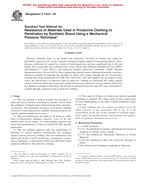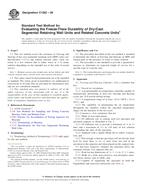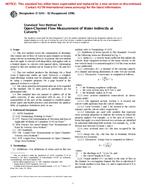1.1 Purpose and ApplicationThis guide summarizes the equipment, field procedures, and interpretation methods for the assessment of subsurface materials and their pore fluids using the Time Domain Electromagnetic (TDEM) method. This method is also known as the Transient Electromagnetic Method (TEM), and in this guide is referred to as the TDEM/TEM method. Time Domain and Transient refer to the measurement of a time-varying induced electromagnetic field.
1.1.1 The TDEM/TEM method is applicable to investigation of a wide range of subsurface conditions. TDEM/TEM methods measure variations in the electrical resistivity (or the reciprocal, the electrical conductivity) of the subsurface soil or rock caused by both lateral and vertical variations in various physical properties of the soil or rock. By measuring both lateral and vertical changes in resistivity, variations in subsurface conditions can be determined.
1.1.2 Electromagnetic measurements of resistivity as described in this guide are applied in geologic studies, geotechnical studies, hydrologic investigations, and for mapping subsurface conditions at waste disposal sites
1.1.3 General references for the use of the method are McNeill
1.2 Limitations
1.2.1 This guide provides an overview of the TDEM/TEM method. It does not provide or address the details of the theory, field procedures, or interpretation of the data. Numerous references are included for that purpose and are considered an essential part of this guide. It is recommended that the user of the TDEM/TEM method be familiar with the references cited and with the ASTM standards D 420, D 653, D 5088, D 5608, D 5730, D 5753, D 6235, D 6429 and D 6431.
1.2.2 This guide is limited to TDEM/TEM measurements made on land. The TDEM/TEM method can be adapted for a number of special uses on land, water, ice, within a borehole, and airborne. Special TDEM/TEM configurations are used for metal and unexploded ordnance detection. These TDEM/TEM methods are not discussed in this guide.
1.2.3 The approaches suggested in this guide for the TDEM/TEM method are commonly used, widely accepted, and proven. However, other approaches or modifications to the TDEM/TEM method that are technically sound may be substituted.
1.2.4 This guide offers an organized collection of information or a series of options and does not recommend a specific course of action. This document cannot replace education, experience, and should be used in conjunction with professional judgment. Not all aspects of this guide may be applicable in all circumstances. This ASTM standard is not intended to represent or replace the standard of care by which the adequacy of a given professional service must be judged, nor should this document be applied without consideration of a project’s many unique aspects. The word standard in the title of this document means only that the document has been approved through the ASTM consensus process.
1.3 Precautions
1.3.1 It is the responsibility of the user of this guide to follow any precautions in the equipment manufacturer’s recommendations and to establish appropriate health and safety practices.
1.3.2 If the method is used at sites with hazardous materials, operations, or equipment, it is the responsibility of the user of this guide to establish appropriate safety and health practices and to determine the applicability of any regulations prior to use.
1.3.3 This guide does not purport to address all of the safety concerns that may be associated with the use of the TDEM/TEM method. It must be emphasized that potentially lethal voltages exist at the output terminals of many TDEM/TEM transmitters, and also across the transmitter loop, which is sometimes uninsulated. It is the responsibility of the user of this equipment to establish appropriate safety practices and to determine the applicability of regulations prior to use.
1.3.4 The values stated in SI units are regarded as standard. The values given in parentheses are inch-pound units, which are provided for information only and are not considered standard.
Product Details
- Published:
- 09/01/2007
- Number of Pages:
- 15
- File Size:
- 1 file , 230 KB


